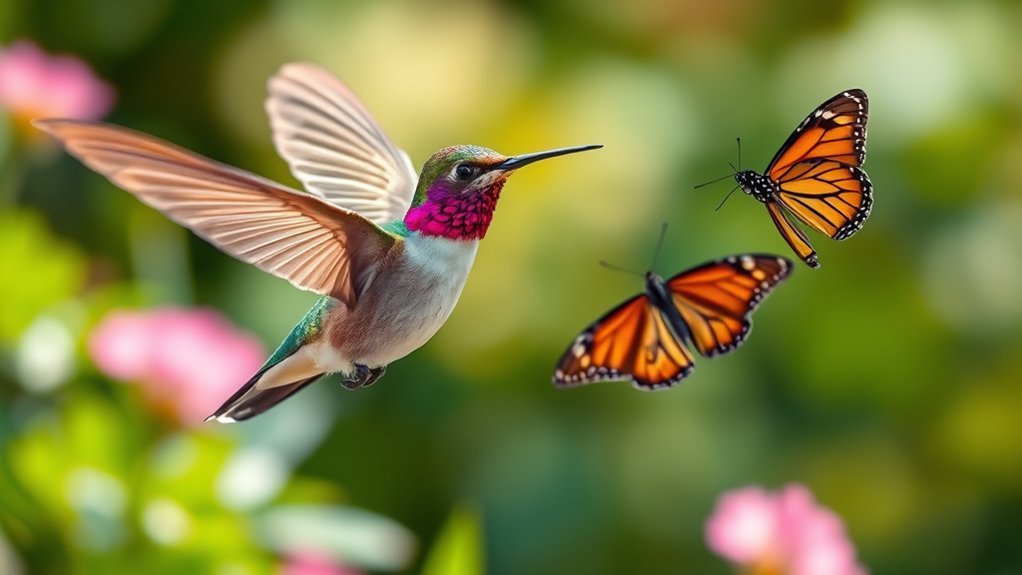How Fast Do Hummingbirds Fly? Speed Insights
Have you ever watched a hummingbird zoom by and wondered how fast it can fly? Hummingbirds typically fly between 20 and 30 miles per hour. Their speed can change based on the type of hummingbird.
Many things help determine how fast they can go. Their size, the shape of their wings, and how they fly all matter. Hummingbirds have special features that help them feed and migrate. Watching them fly shows us just how amazing they are!
A Quick Overview
Hummingbirds are incredible flyers! They usually fly between 20 and 30 miles per hour. That's pretty fast for such small birds!
The smaller ones, like the bee hummingbird, can zoom up to 30 mph. Bigger hummingbirds, however, only reach about 15 mph. Each type of hummingbird has its own way of flying, and that affects how fast it can go and how well it can turn.
Things around them can change their speed too. For example, if it's windy, or if they are close to food, they might fly faster or slower.
When hummingbirds migrate, they can travel more than 500 miles without stopping. They use energy from nectar to keep going on their long journeys. Isn't that amazing?
Overview of Hummingbird Species

Many people see hummingbirds as small, colorful birds that zip around gardens. But did you know there are about 18 different kinds of hummingbirds in North America? Each type has its own home and special traits.
For example, the Ruby-throated Hummingbird loves living in eastern woodlands, while the Anna's Hummingbird likes the coastal areas in the West. These differences affect how they eat, where they go during migration, and how they build their nests.
As you learn about these hummingbirds, you can see how they interact with their surroundings. This shows how each home is important in nature.
Average Flight Speeds of Hummingbirds
Hummingbirds are amazing flyers. They can fly really fast, usually between 20 and 30 miles per hour. This speed helps them move quickly in straight lines.
Their special wings let them flap really fast. This lets them hover in one spot and change directions easily.
Some hummingbirds can fly even faster when they show off during mating. Watching them zip around is truly a sight to see!
Learning about how they fly makes us appreciate these little birds even more. They've cool ways to adapt to their surroundings and find food.
The Role of Wingbeat Frequency

Hummingbirds can move quickly and change directions easily because of how fast they flap their wings. When they beat their wings faster, they've better control in the air. This helps them zip around flowers to get nectar and stay balanced while hovering.
Flapping their wings quickly can use a lot of energy. But hummingbirds have special muscles that help them flap efficiently. This means they can fly a long time without getting too tired.
When you see a hummingbird hovering or darting around, remember that their wingbeat speed is a big part of what lets them fly so well. It's amazing how they've adapted to do this, making them fun to watch for anyone interested in birds!
Factors Affecting Flight Speed
Hummingbirds are amazing flyers, and their wingbeat frequency helps them fly quickly. However, their speed depends on different things.
One key factor is energy. Hummingbirds need to balance fast wingbeats with how much energy they have. If the wind is strong, like when they fly against a headwind, it can slow them down.
But, if they can catch a breeze blowing in their favor, it can help them fly faster.
Food sources also play a role in their speed. If food is nearby, they might fly faster to get to it.
Understanding these factors shows how clever and flexible hummingbirds are in the air.
Comparison of Flight Styles

When you look at how hummingbirds fly, you'll see they've different styles based on where they live and what they want to do. These tiny birds can move in amazing ways.
Some, like the Ruby-throated Hummingbird, are super fast and make quick turns when they're looking for food. Others, like Anna's Hummingbird, fly more smoothly and can stay in one spot while they drink nectar from flowers.
These flying styles help them survive. Some hummingbirds need to chase insects quickly, while others hover to sip nectar.
Learning about how they fly helps us appreciate these beautiful birds and see how they've adapted to their surroundings. It's fascinating to connect with nature through these little details!
The Impact of Size on Speed
Hummingbirds come in many sizes, and their size really affects how fast they can fly. Generally, smaller hummingbirds can fly faster than bigger ones. This happens because small hummingbirds can flap their wings quickly and change direction easily.
For example, the bee hummingbird, which is the tiniest, can zoom around and reach speeds of up to 30 mph. On the other hand, larger types, like the Anna's hummingbird, don't go quite as fast, usually topping out around 15 mph.
Knowing how size affects speed helps us appreciate these amazing birds even more. Nature has some incredible tricks up its sleeve!
Hummingbirds in Migration
Hummingbirds are amazing little birds. They've special skills that help them fly fast and migrate long distances. Some hummingbirds can travel over 2,000 miles during migration.
When they fly, they can hover in one spot. This helps them feed on flowers easily. They drink nectar to keep their energy up for the long trip. Hummingbirds watch the weather and food sources. These signs tell them the best time to migrate.
Learning about how hummingbirds migrate helps us see how tough they are. They face many challenges in nature and still find a way to succeed.
Hummingbirds show us the beauty of speed and instinct as they make their journeys.
Fascinating Facts About Hummingbird Flight
Did you know some hummingbirds flap their wings up to 80 times every second? This fast flapping helps them do cool flips and turns in the air. They can also move in different ways as they travel. Some hummingbirds travel more than 500 miles non-stop when they migrate! This long trip shows how strong they're and how well they know where to go.
When hummingbirds hover in the air, they can drink nectar from flowers that are hard to reach. They're quick too! They can go up and down fast to escape from enemies.
Learning these facts helps us see how amazing these little birds are and how they fit into the places they live. Hummingbirds are truly special!
Frequently Asked Questions
Do Hummingbirds Fly Faster at Higher Altitudes?
Hummingbirds are special flyers. They can adjust to flying at high places where the air is thinner. They do not fly faster up high, but their bodies help them use energy better while flying. This makes it easier for them to move around in the sky, even when the air is not thick. Hummingbirds are really good at flying, no matter where they are.
How Do Weather Conditions Impact Hummingbird Flight Speed?
Weather affects how fast hummingbirds can fly. Strong winds can slow them down and make it harder for them to move quickly. If it's hot or cold outside, it can change how their bodies work, too. This can mean they use more or less energy while flying.
Understanding how weather impacts hummingbirds helps us appreciate these tiny birds even more. It's amazing to think about how they adapt and keep flying despite the challenges!
Can Hummingbirds Hover in Place While Flying?
Yes, hummingbirds can hover in place. They do this because of how their wings work. Hummingbirds flap their wings very fast, which helps them stay still in the air. This makes it easy for them to feed from flowers without moving around. Their special muscles help them balance while they fly. It's pretty amazing to watch!
What Predators Pose a Threat to Hummingbird Flight?
Hummingbirds have to watch out for some tricky predators. Hawks are one of the biggest threats. They can swoop in and catch hummingbirds while they fly. Another danger is snakes. They often hide near flowers where hummingbirds go for nectar. These risks keep hummingbirds on their toes. They must be quick and smart to stay safe and keep flying happily.
How Do Hummingbirds Navigate During Migration?
Hummingbirds know how to find their way during migration. They use two main tools: the Earth's magnetic field and places they recognize.
The Earth's magnetic field acts like a map. It helps hummingbirds know which direction to fly. They also look for familiar landmarks, like mountains, trees, or rivers. These features make their journey easier and help them travel long distances efficiently.
Hummingbirds have a special skill for finding their route. They combine information from nature around them with the Earth's magnetic signals. This way, they get to where they need to go safely.

Luna is the passionate founder and author of Birds and You, a website dedicated to sharing her love for birds with fellow enthusiasts. Through her engaging articles and guides, she aims to educate and inspire others to explore the fascinating world of birds. When she’s not writing, you can find Luna observing birds in their natural habitats or sharing beautiful bird photography on Pinterest. Join her on this journey to celebrate and protect our feathered friends!







